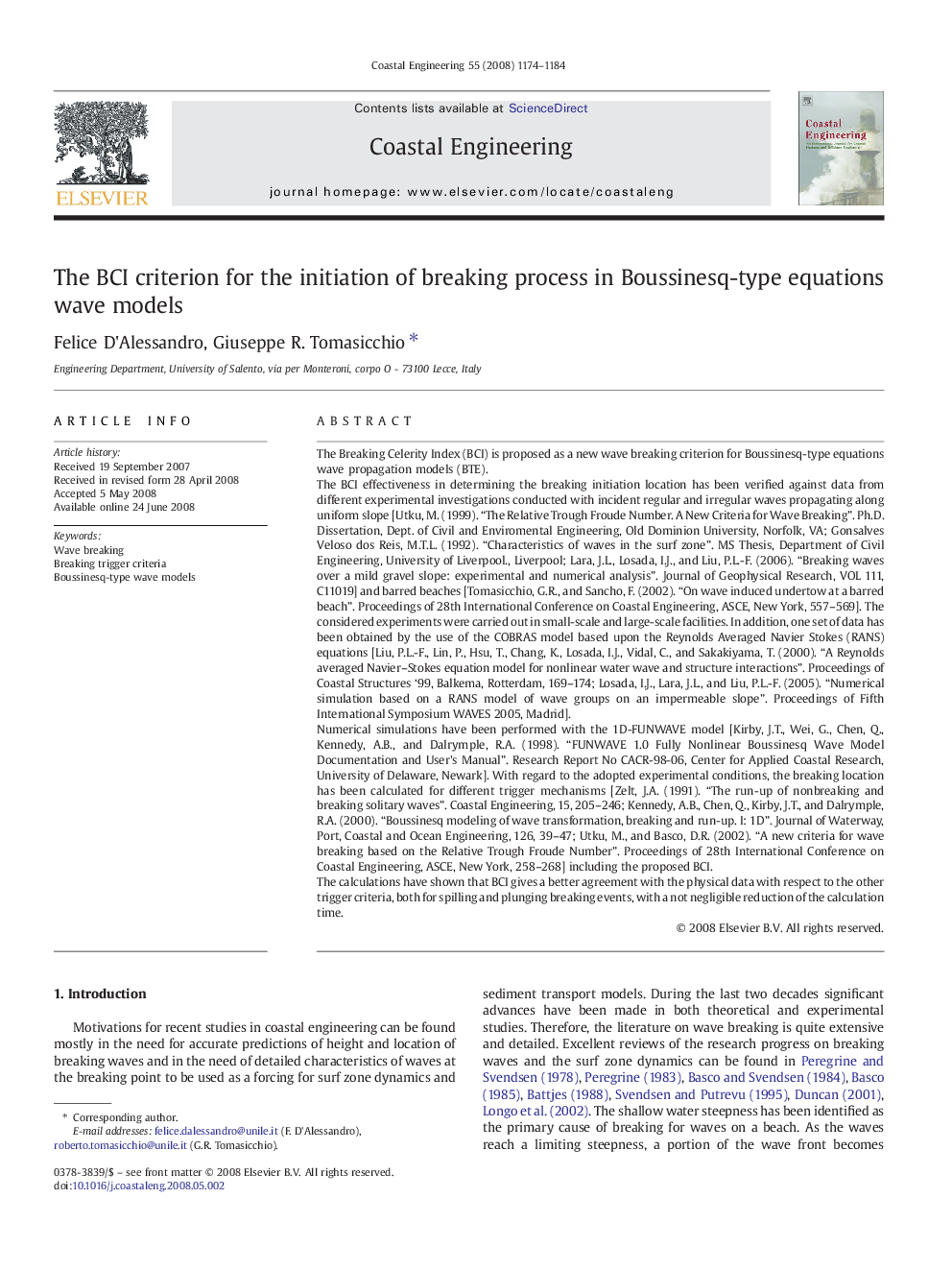| کد مقاله | کد نشریه | سال انتشار | مقاله انگلیسی | نسخه تمام متن |
|---|---|---|---|---|
| 1721330 | 1014483 | 2008 | 11 صفحه PDF | دانلود رایگان |

The Breaking Celerity Index (BCI) is proposed as a new wave breaking criterion for Boussinesq-type equations wave propagation models (BTE).The BCI effectiveness in determining the breaking initiation location has been verified against data from different experimental investigations conducted with incident regular and irregular waves propagating along uniform slope [Utku, M. (1999). “The Relative Trough Froude Number. A New Criteria for Wave Breaking”. Ph.D. Dissertation, Dept. of Civil and Enviromental Engineering, Old Dominion University, Norfolk, VA; Gonsalves Veloso dos Reis, M.T.L. (1992). “Characteristics of waves in the surf zone”. MS Thesis, Department of Civil Engineering, University of Liverpool., Liverpool; Lara, J.L., Losada, I.J., and Liu, P.L.-F. (2006). “Breaking waves over a mild gravel slope: experimental and numerical analysis”. Journal of Geophysical Research, VOL 111, C11019] and barred beaches [Tomasicchio, G.R., and Sancho, F. (2002). “On wave induced undertow at a barred beach”. Proceedings of 28th International Conference on Coastal Engineering, ASCE, New York, 557–569]. The considered experiments were carried out in small-scale and large-scale facilities. In addition, one set of data has been obtained by the use of the COBRAS model based upon the Reynolds Averaged Navier Stokes (RANS) equations [Liu, P.L.-F., Lin, P., Hsu, T., Chang, K., Losada, I.J., Vidal, C., and Sakakiyama, T. (2000). “A Reynolds averaged Navier–Stokes equation model for nonlinear water wave and structure interactions”. Proceedings of Coastal Structures ‘99, Balkema, Rotterdam, 169–174; Losada, I.J., Lara, J.L., and Liu, P.L.-F. (2005). “Numerical simulation based on a RANS model of wave groups on an impermeable slope”. Proceedings of Fifth International Symposium WAVES 2005, Madrid].Numerical simulations have been performed with the 1D-FUNWAVE model [Kirby, J.T., Wei, G., Chen, Q., Kennedy, A.B., and Dalrymple, R.A. (1998). “FUNWAVE 1.0 Fully Nonlinear Boussinesq Wave Model Documentation and User's Manual”. Research Report No CACR-98-06, Center for Applied Coastal Research, University of Delaware, Newark]. With regard to the adopted experimental conditions, the breaking location has been calculated for different trigger mechanisms [Zelt, J.A. (1991). “The run-up of nonbreaking and breaking solitary waves”. Coastal Engineering, 15, 205–246; Kennedy, A.B., Chen, Q., Kirby, J.T., and Dalrymple, R.A. (2000). “Boussinesq modeling of wave transformation, breaking and run-up. I: 1D”. Journal of Waterway, Port, Coastal and Ocean Engineering, 126, 39–47; Utku, M., and Basco, D.R. (2002). “A new criteria for wave breaking based on the Relative Trough Froude Number”. Proceedings of 28th International Conference on Coastal Engineering, ASCE, New York, 258–268] including the proposed BCI.The calculations have shown that BCI gives a better agreement with the physical data with respect to the other trigger criteria, both for spilling and plunging breaking events, with a not negligible reduction of the calculation time.
Journal: Coastal Engineering - Volume 55, Issue 12, December 2008, Pages 1174–1184